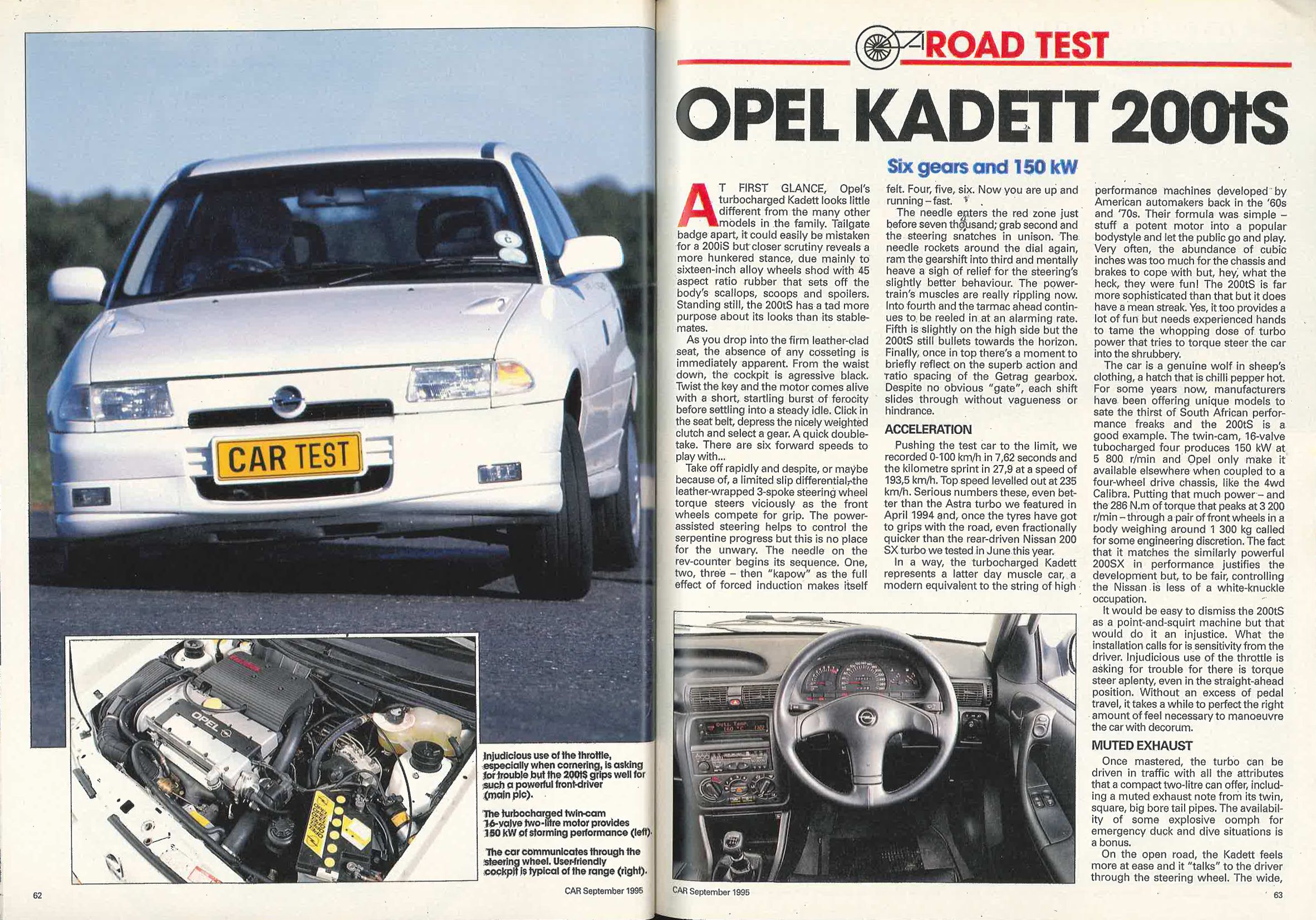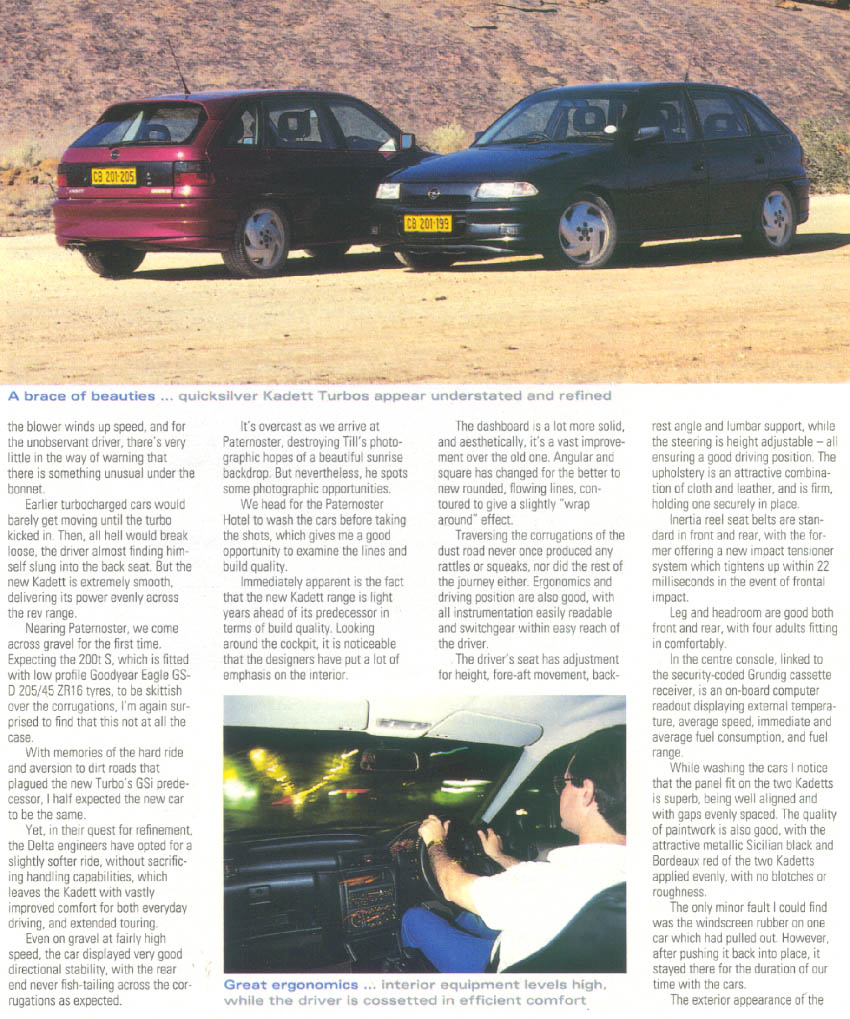Opel "kadett" 200t s (csak Dél-Afrika)
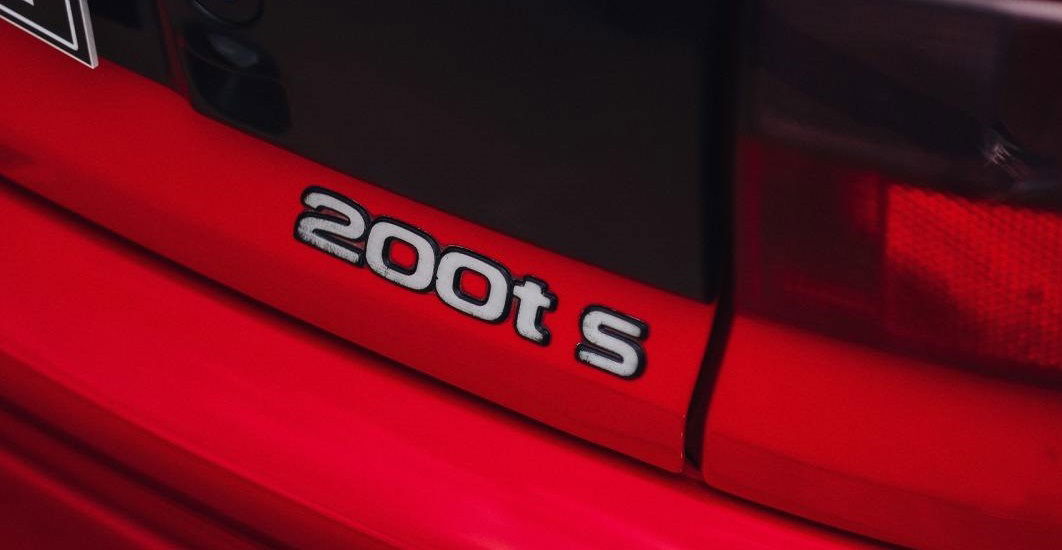
A modellt Dél-Afrikában is indították 1991-ben, ahol a Delta engedélyével gyártották. A "Kadett" nevet 1999-ig megőrizték a ferdehátú járműveknél. A szedán és a caravan modelljeit Astra néven kínálták. A dél-afrikai Kadett és Astra két egymást követő évben (1994 és 1995) elnyerte az „Év Autója” címet, annak ellenére, hogy ugyanazon autó verziói voltak. A dél-afrikai nómenklatúrát centilitrében jelölték, így az Astra és a Kadett sorozat 140, 160i, 180i és 200i modelleket tartalmazott. A karosszéria GSi optikával volt ellátva, de a GSi modellektől eltérően még nagyobb fékekkel és 16”-os könnyűfém kerekekkel rendelkezett melyek a Calibra vagy a A vectra Turbo modellekről ismerős lehetett. A 200 t S volt egy konkrét név, ahol a Delta Motor Corporation meg akarta mutatni a típus specialitását, amely abban az időben egy negyed mérföld gyorsuláson verte a BMW M3-at. A "t" a turbófeltöltőt jelenti. Az Opel Astra és a Kadett 200t S motorját (C20LET) az Opel Calibra és az Opel Vectra A 4x4 2.0 16V turbóból, négykerék-meghajtásból, az európai piacokon találták, de a helyi mérnökök átalakították a hatfokozatú, négykerék-meghajtó sebességváltót (Getrag F28) csak az elsőkerék-hajtáshoz, és mint ilyen, Dél-Afrikában egyedi volt. Dél-Afrikában volt egy speciális Astra GSi származék, annak ellenére, hogy ilyenként nem ismerték. Az Astra vagy a Kadet 200TS.A Calibra Turbo technológiát beépítették a jobb irányítású Astraba, és 160 kW-ra emeltek. Valószínűleg az Opel és a Delta Motors együttműködött Dél-Afrikában.A 234 km / h csúcs és a 0-100 km / h gyorsulás 7 másodperc alatt meglehetősen lenyűgöző érték. Érdemes megjegyezni, hogy itt van a teljes (!) GSi spoiler az 5 ajtós és a sedan változatnál is. Az 1993 és 1996 között, a dél-afriai Port Elizabethben összeszerelt 350 darab autó motorja és karosszériája is egyedi megrendelésre, Szentgotthárdon készült. Az összeszerelést az 1986-ban alapított, dél-afrikai Delta Motor Corporation készítette, ami korábban 45%-ban, 2003-tól viszont 100%-ban a General Motors tulajdonában van. A C20LET motorkódú aggregáthoz, a 4X4 hajtás helyett ez esetben csak elsőkerék meghajtás párosul, amit egy Getrag F28-as, hat sebességes kézi váltón keresztül mozgat a motor. A dolog pikantériája, hogy különböző turbónyomással is készült az autó. Az alap turbónyomás, 0,55 bar, amellyel 207 lóerőt tudott, de egészen 1,8 bar-ig volt húzható, amellyel 370, a megfelelő átépítéssel pedig akár 700 lóerőt is tudott. A dolog legérdekesebb része, hogy 1993-ban és 1994-ben elnyerte a dél-afrikai Év Autója címet is, de a legendák szerint negyed mérföldön még a BMW M3-ast is maga mögé utasította.
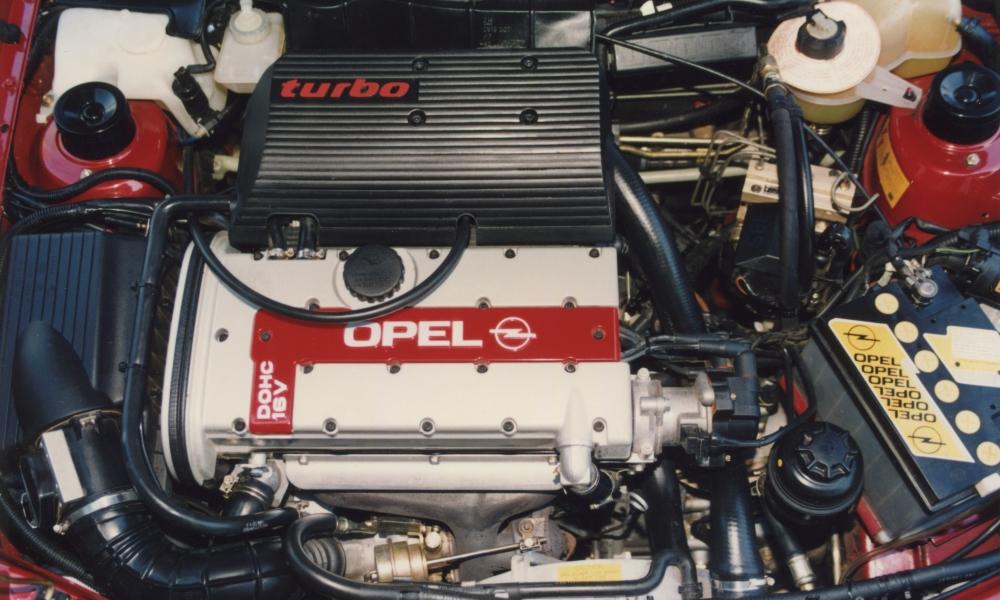
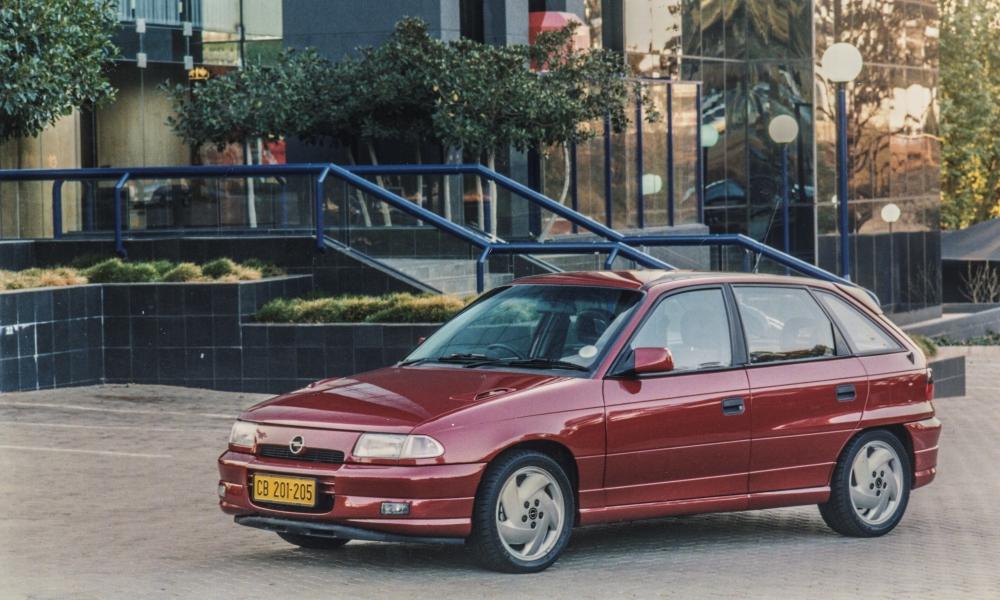
Picking up where the "Superboss" left off, this was a turbocharged tyre-shredder that packed 150 kW of power and a novelty for the time - a six-speed gearbox. It was a bit of a handful, however...
Forrás: https://www.carmag.co.za/news-blog/from-the-archives-ope-kadett-200-ts/

We take a closer look at the definitive hot hatches of their era: the Opel Kadett Boss, Superboss and Turbo...The performance-focused Opel Kadetts of the late-1980s to mid-1990s have become the stuff of legend in South African automotive history. We’re focusing here on the various versions of 2,0-litre hot-hatch Kadetts, spanning two generations of the vehicle.First there was the “Boss”, the 200i GSi with its s-o-h-c, eight-valve-head naturally aspirated petrol engine developing 95 kW. Next came the 1989 twin-cam, 16 V, 115 kW 2,0 GSi 16V, earning the nickname “Big Boss” (mainly during 1991 to 1992; its official nomenclature changed to 200i CD 16 V).Then arrived the 200 GSi S that received a power boost to 125 kW via tweaking of the cam profiles to give more lift and overlap. This was dubbed the “Superboss” and 500 were built for homologation for Group N racing.Lastly, there was the outrageous 200 ts that developed 151 kW with the help of a turbocharger. Part of a new generation of more refined, better-quality Kadett models, by now the “Boss” monikers had run dry, which is a pity as “Ultraboss” may have been fitting.All this excitement took place in the humble Opel Kadett range – then sold by Delta – over a mere eight years and a pair of generations.
Packaging
With no over-the-top styling, massive wings or fancy interiors, these were real wolves in sheep's clothing. The Kadett’s bodywork and trim were substantially updated in 1993, adding more strength and safety at the expense of extra mass. The booted version of the revised Kadett received the Astra title.In the United Kingdom, Opels are badged as Vauxhalls. That name comes from the Vauxhall Ironworks company, which started life in 1897 and became a subsidiary of General Motors in 1925. Why do I mention this, you ask? Because a number of local General Motors fans import Vauxhall badges and fit them to their Opels to stand out a bit more from the crowd (and perhaps to trick the non-petrolheads into thinking their cars are more exclusive).
Powertrain
Opel took its 16 V, 2,0-litre transverse four-cylinder twin-cam (20XE) producing 115 kW and then tweaked it to deliver 125 kW in the Superboss models. Sodium-filled valves helped top-end cooling and it had a head designed by Cosworth, with fuel injection by Bosch Motronic. To cope with the increased power, forged pistons, increased compression ratio and more radical valve timing overlap were employed.For the 200 ts, Delta added a KKK turbo and, to manage the 151 kW of power, Opel mated a six-speed Getrag gearbox that could handle the extra stress. Six-speed gearboxes were very cutting edge in the 1990s and we clocked the Superboss’ top speed at 223 km/h and the 200 ts at 235 km/h (true speed).Interestingly, South Africa was the only market in the world to use the turbocharged petrol engine in front-wheel-drive form. Elsewhere, it was mated only to all-wheel-drive models such as the striking Calibra Turbo.
Which one to get...
Any car that has been well cared for, or perhaps restored, should have potential. The turbo cars would have lived an especially hard life, so find out what has been rebuilt and what still needs doing.
What to watch out for
Some aluminium cylinder heads can become porous, allowing oil to ooze into the coolant system and leave a brown emulsion. Changing the oil regularly may help alleviate this problem, but specialist companies should repair it. It was a problem in production that was remedied by forcing the aluminium into the casting die under pressure rather than using gravity.
Availability and prices
There will always be a few available for purchase and some owners spend a lot of cash keeping them running smoothly. This means they won’t sell cheaply unless you are left with some of the fixing up to do yourself.
Interesting facts
When we tested the Superboss, we battled to match the results we got from the Big Boss. A second car was tested, but consultation with Delta’s engineers and testers could not establish the problem. A possible conclusion was that the original Big Boss test unit was producing more than the average output given that no two identically specced engines ever produced exactly the same output.Another oddity is that the Superboss test car speedometer went up to only 220 km/h so, on the top speed run, the needle went “off the clock” to achieve 223 km/h. The 200 ts rectified this by going overboard with a speedometer reading a very optimistic 280 km/h.In 1995, the 200 ts was one of the fastest-accelerating cars, outpaced only by the likes of Audi Quattros and BMW M3s. No automatic cars could touch it, either.
Forrás: https://www.carmag.co.za/news/buying-used-cars/classic-buy-opel-kadett-boss-superboss-turbo/
Opel Kadett 200tS: The Golf GTI Destroyer
Not too long ago, I showed you the Opel Superboss, one of a few South Africa-only specials. The car I’m going to share with you today is even more epic. This is the Opel Kadett 200tS – 151kW (205hp) and 286Nm (211ft-lb) of Golf GTI-destroying performance.The year was 1994, and Delta, the local arm of Opel in South Africa, decided that their 96kW (128hp) naturally aspirated Kadett 200iS hot hatch wasn’t quite hot enough. Well, either that or they were just bored and wanted to play around, who knows…
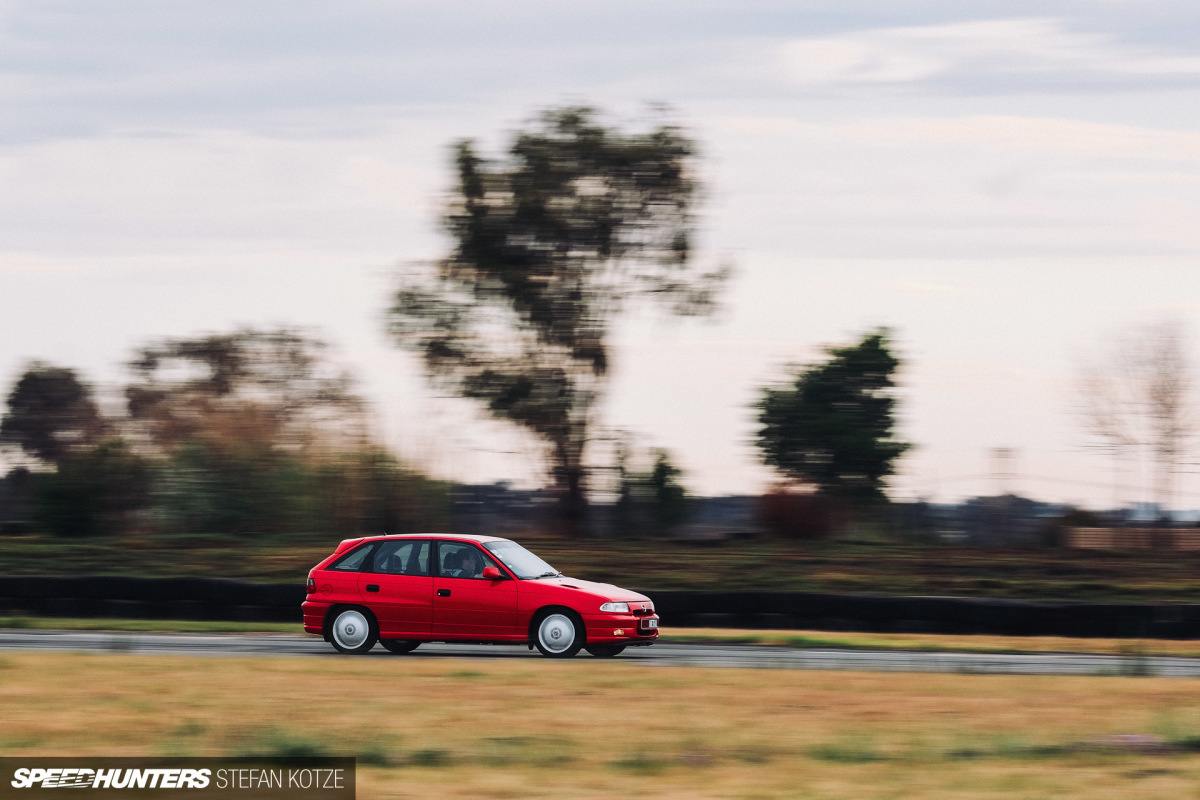

The 200tS really was really a wolf in sheep’s clothing, as apart from different wheels – silver 16-inch, 5-spoke numbers – and a single badge on the back, it looked no different than the 200iS it was based upon.



This specific 200tS is in 100% original and unrestored condition; I can’t actually believe how good it still looks for a 25-year-old car. It’s not the only example its owner has in his garage either, although the other one is highly modified.

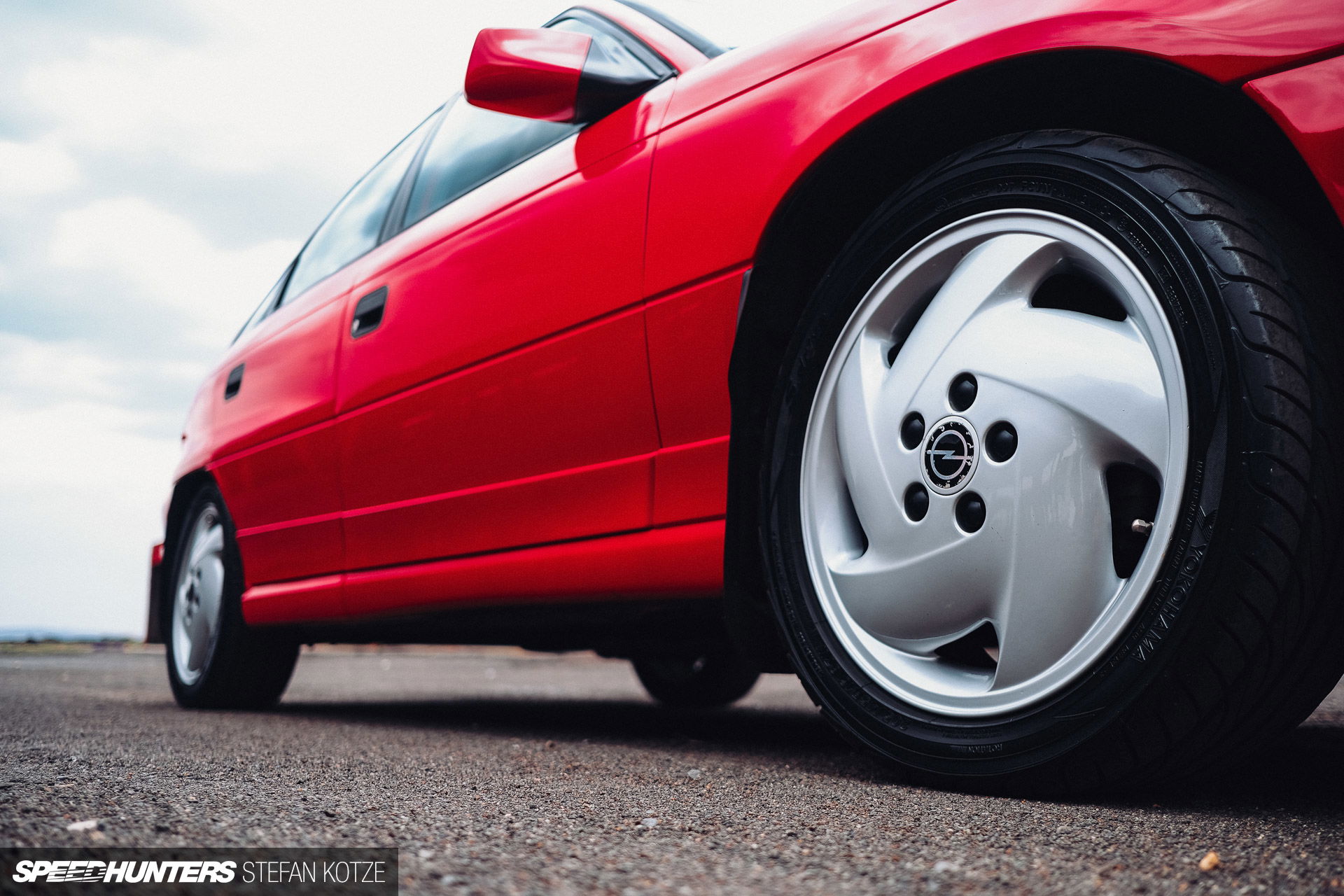
The tS had a 0-100km/h time of 7.62 seconds, and was able to complete a standing kilometer run in 27.90 seconds at 193km/h. Anyone game enough to keep their foot up it could reach 253km/h in the right conditions.

At the heart of the 200tS’s performance credentials was its 2.0L DOHC 16V engine, which with the addition of a KKK turbocharger was able to achieve the previously mentioned maximum power and torque figures – big numbers for the day. The intercooler arrangement as well as the engine management system was researched, developed and manufactured locally in South Africa.Early cars actually produced 160kW (214hp), but according to rumours they experienced overheating problems, so from the middle of 1994 cars were listed with a lower 151kW (202hp) output and came fitted with a larger aluminium radiator.By comparison, the Kadett 200tS’s main rival, the Mk3 Volkswagen Golf GTI, produced a meagre 85kW (114hp) and 166Nm (122ft-lb), and even the VR6 with its large 2.8L V6 engine could only manage 128kW (171hp) and 235Nm (173ft-lb).


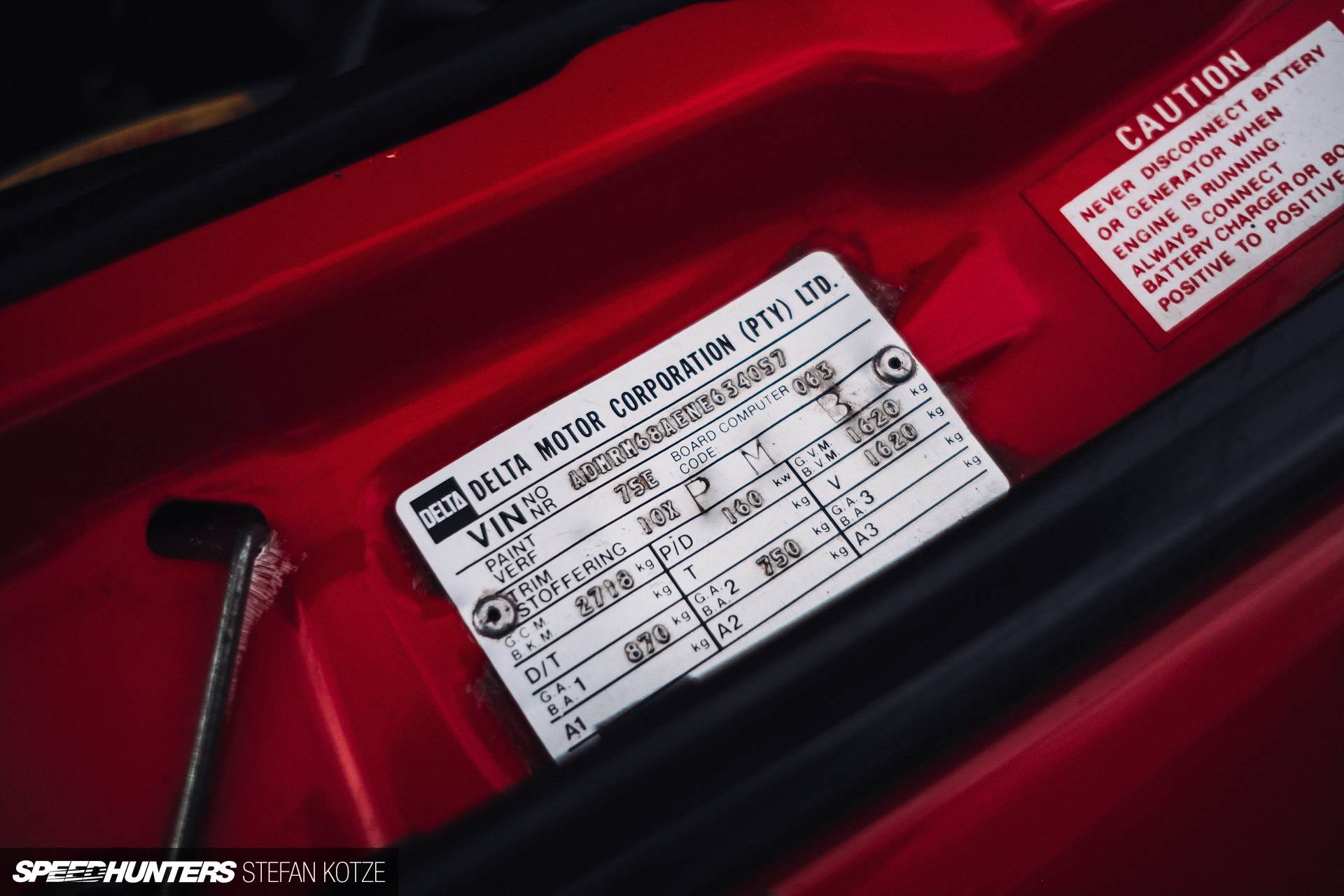
Internally, the four-cylinder resembled that of the engine in the 4WD Opel Calibra Turbo, but this one put its might down exclusively through the front wheels, so traction was always going to be an issue. The engine was paired with a 6-speed Getrag transmission – an advanced and quite uncommon thing for the time – fitted with a limited slip differential.The LSD unit was developed by Gemini Transmissions in the UK, a company actually started by South African motorsports legend Andre Verwey, and was fitted to the transmissions in Germany before export. It’s rumored that part of the deal required all gearbox repairs to be done on an exchange basis with Getrag. Broken units had to be returned to Germany, with Getrag even refusing to supply Delta with the special tools required for stripping and rebuilding the gearboxes.
Handling wise, the 200tS featured independent front and semi-independent rear suspension, and ABS braking was standard fare too.Supposedly, Delta offered a special advanced driving course to buyers of the car, in the hope it would provide them with the necessary skills to get to grips with this powerhouse machine. Either this didn’t work, or people were just too confident, because a lot of these cars were crashed, which makes find a good clean example today extremely hard.

South African automotive enthusiasts weren’t the only ones to take an interest in the Kadett 200tS either. The South African Police Service (SAPS) equipped their high-speed pursuit department, otherwise known as the Flying Squad, with the model, which made evading the law a lot harder for anyone hoping to make a quick getaway.
The 200tS’s interior was a simple and straightforward affair. In fact, the only reminder a driver got that he was behind the wheel of something special was the 280km/h speedometer, and the ’16V TURBO’ insignia below it.





I can’t remember the last time I saw a cassette tape head deck and a security gear-lock in a car, but all ’round this car just screams the ’90s.

The Kadett 200tS was a real firecracker back in its day, and with only 500 cars ever rumored to have been built (the official number is unknown), 25 years on they’re now more sought after than ever. But with so many of them having been written off, banged up, and molested over the last quarter century, finding one, let alone in decent condition, is only becoming harder, hence why their value continues to rapidly increase.Thankfully, there are still examples like this to remind us of an amazing era of performance motoring in South Africa.
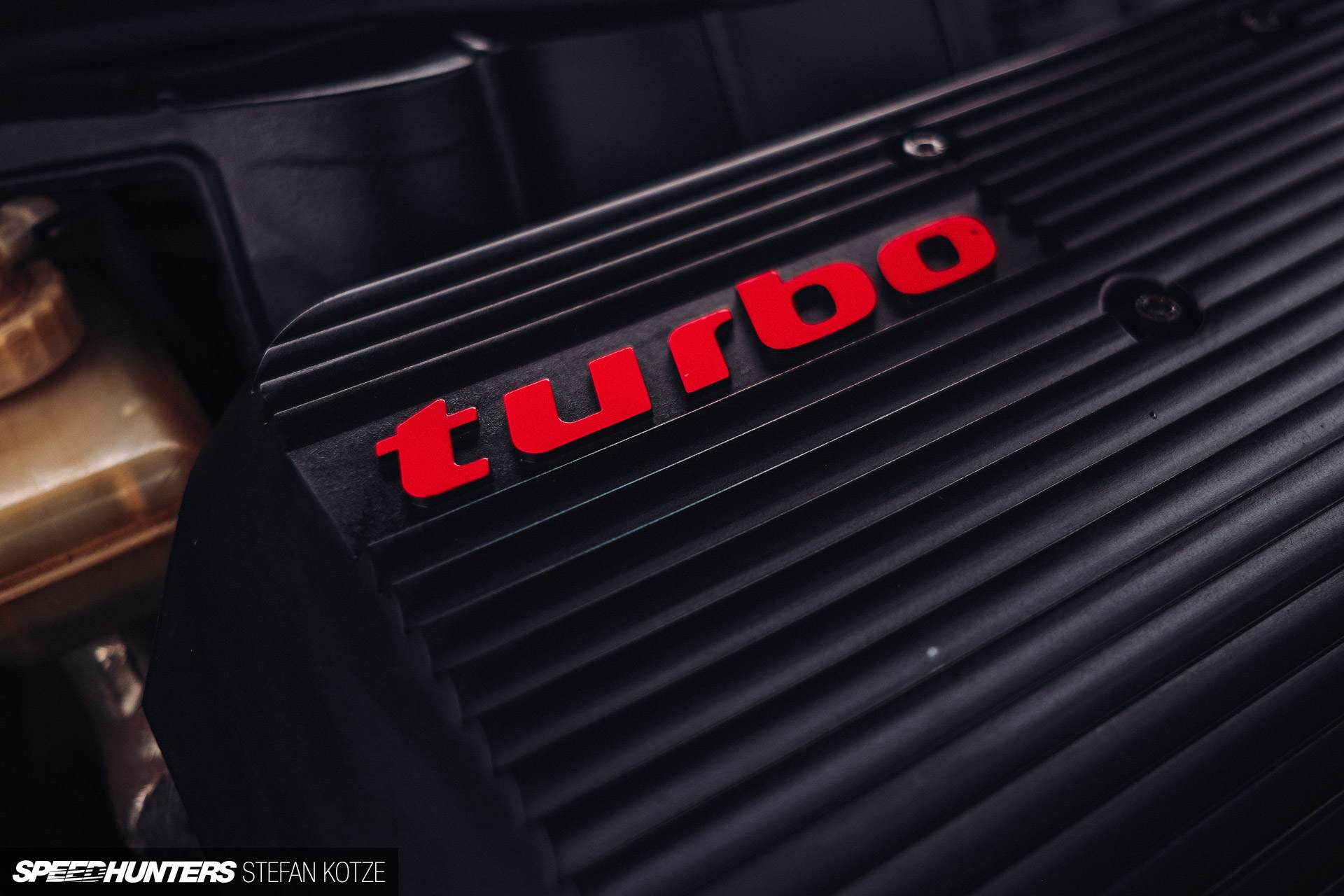

Forrás:
http://www.speedhunters.com/2020/03/opel-kadett-200ts/
by Deon Venter (Opel Zone):The Kadett / Astra 200ts was developed in conjunction with Adam Opel AG, with some of their engineers here to oversee the development phase. The drivetrain was taken from the Calibra turbo and shoehorned into the Kadett and Astra nose. Although the Calibra is a 4-wheel drive car, the local model was frontwheel driven. Local development of the drive system was done. The Kadett and Astra 200ts (turbo 6 speed) models were initially launched during 1994, but were withdrawn shortly afterwards. The car apparently suffered heating problems.An interesting note from the consumer's point of view was the fact that a test drive was almost out of the question as dealers wanted to see a solid deal first. The salespeople mainly gave the enormous power of 160kw for the car as an excuse as they might suffer at the hands of inexperienced drivers. The buy also included a free driver training course. Interestingly Delta all so offered the driving course for buyers of the previous generation Superboss.It rejoined in 1995 for the year. I think both the 200is and 200ts models received the larger aluminium radiator. The turbo Kadett was the car most Opel drivers at the time aspired to, but it proved to be quite expensive. List prices at the time was very close to the Golf VR6, which many people rated as a bechmark in this class. The 200ts proved them wrong. The VR6's only virtue is the longer model lifecycle.The 200ts proved to be a fragile car as the gearbox is prone to a 6th gear breakage when was constantly driven hard. Rumour has it that these gearboxes are quite scarce and expensive nowadays. Care has to be taken when looking for used version of the ultimate Kadett and Astra, because of their performance credentials. At all speed events these cars prove to be extremely fast. With a little modification speeds up to 250 km/h is possible. Incidentally the standard car easily sees off the M3 over the quatermile.This is only one of the real performance Opels we enjoyed in this country over the past decade.


Owning the Kadett 200ts: Mark Jones (December 98)
I have a late 95 model and thank goodness by then most of the bugs from the initial car had been ironed out. The later model has full leather and the over heating problem has been sorted out, my car does not go over 1/4 on the temp. gauge even if I am driving like a loony. I believe the biggest reason the car in general was refined from 160 kW to 150 kW and then eventually stopped was because it was not allowed to compete in Group N where it would have gone up against the M3. Delta saw no reason in continuing in building a high maintenance car that would give them no advertising mileage on the race track ( BMW withdrew their M3 from Group N because they saw no reason in running a car without competition ).The Ts will give you many miles of trouble free pleasure, provided it is properly maintained. I change oil (Castrol fully synthetic), filter and plugs every 5000 km and then still have the car serviced at the agents at the recommended 15000 km intervals. I also run the car on the dyna every couple of months, just to make sure everything is in order. Another little thing I do religiously is whenever I drive the car I allow it to idle for at least 30 seconds before switching it off.One of the biggest problems with the Ts is not the car itself but the people who butcher them. I have spoken directly to one of the fundis at Bosch , the Ts as it comes out the factory is pretty much on the limit when it comes to set-up. The car runs 0,7 bar boost with a 9:1 compression ratio, which they reckon is just about as good as you will get on pump fuel. The standard car should run all day without breaking, it is only when you chip or modify the car and start loading the components more than you should, that's when gearboxes and motors start breaking .A modified Ts is a good weekend car , that is capable of seeing off almost any other car. Sure you will blow that M3 into the reeds initially and maybe even after the M3 hits limiter but the M3 will run all day on the limiter and I have yet to see a modified (increased boost) Ts run for 20 km`s flat out. The bottom line is, out the factory the Ts is fast and reliable, modify it and it will break.As an everyday car the Ts is the most rewarding Opel I have ever owned (previous Opels, 87 1,8 Gsi, 89 2,0 Gsi , 91 Superboss, 94 160is). You can trundle along at idle or fly along at pace it makes no difference. Fuel consumption is directly linked to your right foot, my first auto card is currently on a 10,8 km / litre average, not bad considering that when you run top end you get about 7 km / litre. Handling is superb provided the road is dry and smooth but even on a good road the limited slip diff can be quite vicious.The level of grip is amazing but because of this, if it lets go you will be far beyond bringing it back. Braking is also out of the top draw mainly because of the ABS but it does tend to go through disks and pads rather quickly. A tip to improve the feel of the car and blunt some of its unpredictability is fit a set of coil springs and a set of 17" mags and tyres, the difference is chalk and cheese.The main reason I will not part with my Ts for love or money is because I have the best of both worlds, one moment I have a mild, torquey and conservative road car and the next a wild, turbo charged race car.
Sunday classic: Opel Astra/Kadett 200tS
In the late 1980s, General Motors’ former South African importer Delta Motors Corporation set off to design a locally-built hot hatch based on the Opel Kadett. Called Kadett Superboss, it earned the distinction of being one of the most desirable Opel-badged performance cars of the era and several examples were imported to mainland Europe by private buyers.The hot hatch segment moves quickly and importer Delta Motors wasn’t able to rest on its laurels for very long. To build upon the Superboss’ success, the firm began developing a performance car based on the then-new Kadett/Astra that it promised would outrun the factory-built GSi 16v model.Called 200tS, the range-topping Kadett and Astra models perfectly demonstrated the concept of a wolf in sheep’s clothing. When viewed from the outside it was hard to tell them apart from regular GSi 16v models because the two shared the same aesthetic and aerodynamic body upgrades. A well-trained eye immediately spotted the 200tS’ five-bolt 16-inch alloys, however.Delta could not hide the Kadett/Astra’s Teutonic influence and the dashboard had a clean and relatively well laid out design with absolutely nothing extravagant to it. Engineers wanted to avoid adding superfluous equipment to keep the weight low, but they also had to pack the car with a number of high-tech features in order to partially justify its high price. As a result, the 200tS models were equipped with an on-board computer, front power windows, air conditioning (a must in South Africa, we’ve been told), power mirrors and a three-spoke steering wheel that did not feature an airbag. When all was said and done the Kadett 200tS tipped the scale at 2866 pounds (1300 kilos).Mounted transverally in the Astra’s engine bay was a 2.0-liter 16-valve four-cylinder engine that was borrowed from the four-wheel drive Calibra Turbo. It initially churned out 214 horsepower and 206 lb-ft. of torque but the early cars were plagued with chronic overheating problems so Delta temporarily stopped production until it found a cure. Starting in 1995, all 200tS models were fitted with a larger aluminum radiator and saw their power output reduced to 202 horsepower and 210 lb-ft. of twist.Before fitting the drivetrain to the Kadett/Astra, Delta converted it from four- to front-wheel drive, a task that was said to be absolutely gargantuan. The transmission was left out of the deal and replaced by a six-speed unit sourced from Getrag in Germany, and a limited-slip differential was fitted as standard to keep the extra power in check.With the turbocharged 2.0-liter, the Kadett sprinted from zero to 62 mph (100 km/h) in 7.6 seconds and went on to a top speed of 146 mph (235 km/h), stellar figures on both accounts, especially considering the Kadett was initially designed as little more than an economy hatchback.An article published in South African magazine TopCar indicates that Getrag agreed to provide Delta with the transmission on the sole condition that all units were to be returned to Germany for any and all repair work, not mended locally. This process evidently cost a small fortune and many owners swapped out their broken six-speeds in favor of a five-speed unit that could be repaired without calling FedEx.REPORT THIS ADTo ensure that the 200tS’ braking system was up to par, Delta equipped both the Kadett and the Astra with Calibra discs up front and standard ABS.The aforementioned article in TopCar claims that about 500 Kadetts and 350 Astras were built up to 200tS specs between 1992 and 1996. The Kadett cost 127,100 South African Rands in 1995.

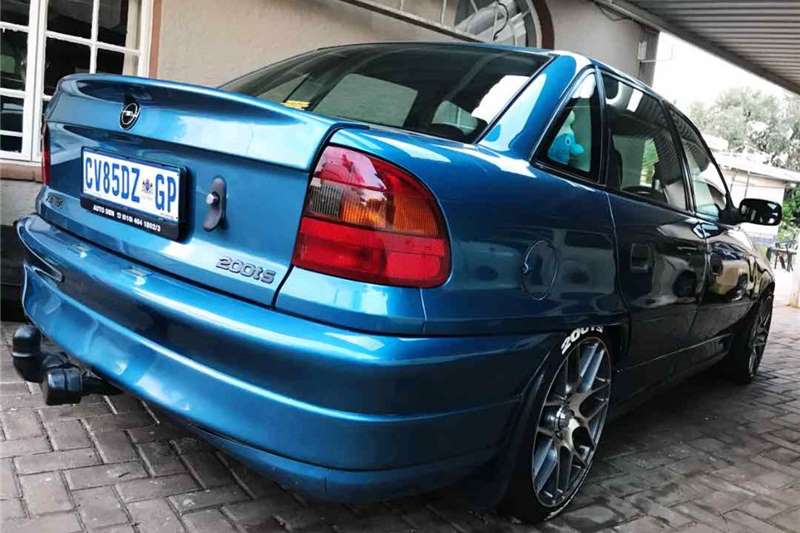

The Opel Kadett 200tS was very similar to an old school American muscle car. The formula was simple – stuff a potent motor into a popular bodystyle and let the public go and play. That said, the 200tS was far more sophisticated that the muscle cars of the 60s and 70s, but like those, it had a mean streak. It provided lots of fun, but needed an experienced hand to tame the turbo power and torque steer, or else it was all too easy to end up flying off the road. The only giveaway to the tS’ sporty credentials were the badge at the back, and its low profile shod 16” wheels – apart from that, the 1.2 ton hot hatch was a wolf in sheep’s clothing. The drivetrain was taken from the Opel Calibra turbo and shoehorned into the Kadett and Astra nose. Although the Calibra was a 4-wheel drive car, the local model was front wheel driven. Local development of the drive system was done, so make it work. When the 200tS launched in 1994, its 16V 2.0-litre turbocharged motor produced 160kw, but in 1995, it was detuned to 151kw. Rumour has it, that the car suffered from overheating, resulting in models receiving a larger aluminium radiator. In both variants – power was sent exclusively to the front wheels via a 6-speed manual Getrag gearbox. Interestingly, the detuned tS was slightly quicker, posting a 0-100kph time of 7.62 seconds, and a standing kilometer time of 27.90 at 193kph. It eventually maxed out at a true speed of 235kph, even though the speedometer read 250kph. The 200tS proved to be a little fragile as the gearbox was prone to a 6th gear breakage when was constantly driven hard. Rumour has it that these gearboxes are quite scarce and expensive nowadays. Handling was sorted thanks to independent front suspension, and semi-independent rear suspension that was a mix of compound links with semi-trailing arms and a torsion profile, while braking thankfully include ABS. Care has to be taken when looking for used version of the ultimate Kadett and Astra, because of their performance credentials, they were frequently abused. Interestingly Delta offered an advanced driving course for 200tS buyers, because they felt inexperienced drivers needed to have an in-depth understanding of the car before finding its limits. When the 200tS was launched in 1994, it was priced very close to its primary competitor, the Volkswagen Golf VR6. The 200tS stood at R112 050, while the VR6 was at R117 044. A year later, the 200tS’ priced rocketed to nearly R130 000! The tS was deemed a car for serious enthusiasts. And now, almost 25 years later, it is still as respected as the day it rolled off the production line. Now that is a proper performance icon.

Régi Brosúrák
